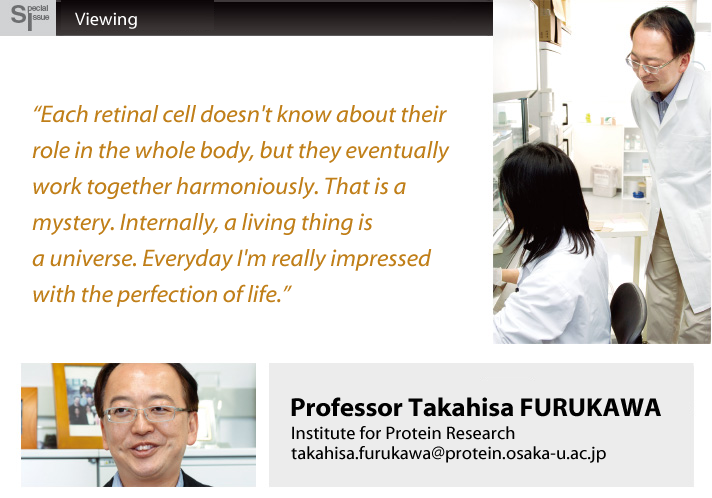
Clarifying the roles genes play in the development of the retina
Professor Takahisa FURUKAWA is involved in retina research and has clarified major mechanisms in the generation, differentiation, and maturation at the molecular level of photoreceptor cells in the retina. For his achievements, Prof. Furukawa received the 30th Osaka Science Prize in 2012.
Absorbed in his research and the causal relationships he discovers among genes, he encourages young researchers to work pursuing their dream. At the same time, as a doctor, he encourages patients, reminding them that new developments are always taking place in medicine and not to lose hope.
Major discovery
What types of ion channels were involved in the recognition of light and darkness had not been known, but under Dr. Furukawa's leadership, a group of researchers clarified the molecular level mechanism for retinal ON bipolar cells whose excitement was increased by light stimulation. The group also announced that changes in TRPM1 channels, a major mechanism, caused congenital night blindness.
With positive intent to explore the mystery of differentiation at the genetic level, Professor Furukawa started molecular biology research at graduate school in 1988. In the previous year, Professor Cepko of Harvard University published in
Nature
that different neural cells were derived from common progenitor cells. Enchanted with this discovery, he later studied under the instruction of Professor Cepko.

Patients, don't lose hope.
Prof. Furukawa paid particular attention to the retina as a part of the central nervous system and identified a variety of transcription factors expected to control visual cells. Furthermore, he discovered Cone rod homeobox (Crx), a master control gene of retinal cell differentiation and clarified that changes in Crx were causal genes of retinitis pigmentosa. This discovery led to a marked development in the field of visual science at the molecular level and Crx is used as an important marker for inducing visual cells in generative medicine.
Based on these achievements, he delivers lectures to groups organized by patients with retinitis pigmentosa. He would like to give patients hope and security by talking about his research achievements and future prospects.

INTERVIEW with Professor FURUKAWA
The pleasure of discovering something -- Winning the Osaka Science Prize
Why were you awarded the Osaka Science Prize?
"Fertilized eggs are genetically programmed to differentiate and develop advanced neural functions in a mature body. My research clarified how such a complex growth process is conducted in 22,000 gene loci.
"While I was studying in the U.S. and considering the importance of a transcription factor that binds to specific DNA sequences, thereby controlling the transcription of genetic information, I made every effort to find a variety of factors. The identification of a homeobox gene, rax (retina and anterior neural fold homeobox), that plays an important role in eye development was my greatest achievement.
"I also clarified the cascade in retinal development involving Cone-rod homeobox (Crx) as a key transcription factor and the mechanism for visual cell specification."
A unique name of Pikachurin
Not only your achievements, but also your unique way of naming has attracted public attention.
 "How visual cells form neural circuits, connect with bipolar cells (secondary neurons), was not known. I identified the protein that was necessary in the interactions between them, naming it Pikachurin, after Pikachu, a popular anime character in Pokemon. The name of this protein was inspired by Pikachu's "lightning-fast moves and shocking electric effects". It wasn't just for fun, but I wanted to encourage the achievements of Japanese researchers and impress people.
"How visual cells form neural circuits, connect with bipolar cells (secondary neurons), was not known. I identified the protein that was necessary in the interactions between them, naming it Pikachurin, after Pikachu, a popular anime character in Pokemon. The name of this protein was inspired by Pikachu's "lightning-fast moves and shocking electric effects". It wasn't just for fun, but I wanted to encourage the achievements of Japanese researchers and impress people.
Likewise, Crx stands for cone and rod of visual cells, but actually, I was inspired by a Honda CR-X which was parked at a parking lot at the Harvard University where I was working at that time.
Living organisms are really elaborately made
You enrolled in the Faculty of Medicine and ended up serving as a researcher, didn't you?
 "While visiting labs, I was fascinated by the research being conducted. My basic approach to research is to clarify principles. I hope such clarification will lead to the identification of causes of diseases and to regenerative medicine. I'd like to help people as a researcher in the fields of health and life.
"While visiting labs, I was fascinated by the research being conducted. My basic approach to research is to clarify principles. I hope such clarification will lead to the identification of causes of diseases and to regenerative medicine. I'd like to help people as a researcher in the fields of health and life.
Knowing the results of my research first is also very exciting. There are methodological approaches to pursue theories and laws, but I like to achieve something through repeated experiments. For example, in understanding the forest, some researchers seek tree pattern laws using differentiation and integration, but I prefer to fully examine each leaf and complete one of the trees in the retina. This is the way I conduct my research."
"The more I search, the more I find I don't know. For example, each retinal cell doesn't know about their role in the whole body, but they eventually work together harmoniously. That is a mystery. Internally, a living thing is a universe. Everyday I'm really impressed with the perfection of life. I hope I can pass on this fascination to young students and researchers."